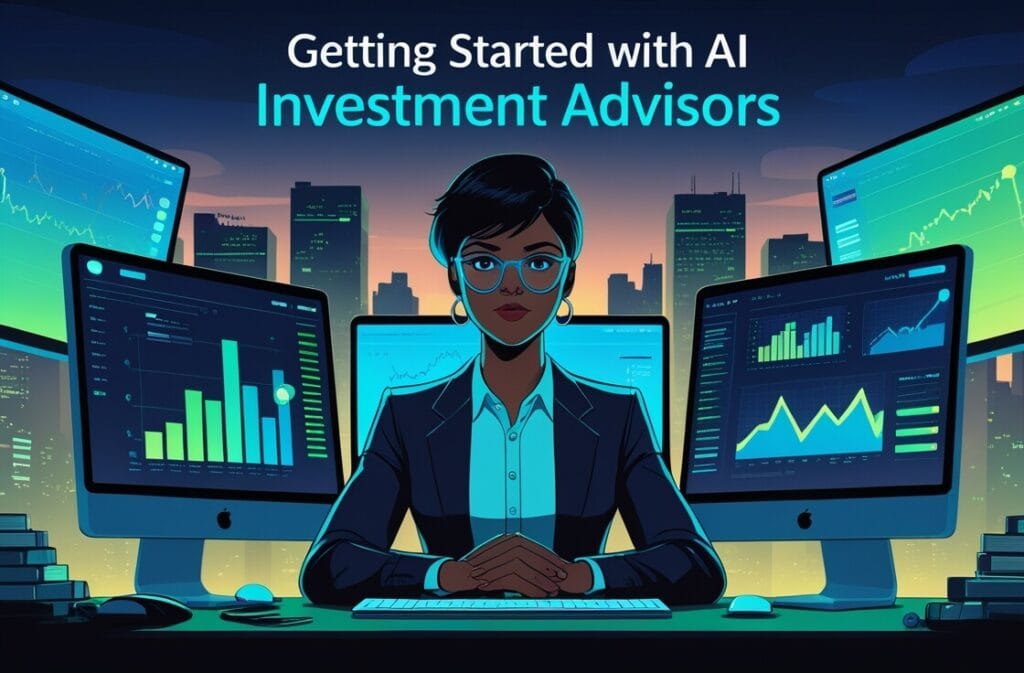
Remember when getting investment advice meant scheduling appointments with expensive financial advisors and paying hefty fees? Those days are quickly becoming history! AI investment advisors have burst onto the scene, and honestly, they’re changing everything about how regular folks like us build wealth.
I’ll never forget my first encounter with an AI investment advisor back in 2019. I was skeptical as heck – how could a computer possibly understand my financial goals better than a human? But after watching my automated portfolio consistently outperform my amateur stock-picking attempts, I became a believer. The numbers don’t lie: AI investment advisors now manage over $1.4 trillion in assets globally, and that figure is expected to triple by 2027!
These digital financial advisors aren’t just a trend – they’re fundamentally reshaping how we think about investing, making sophisticated wealth-building strategies accessible to anyone with a smartphone and a few hundred dollars to start.
What Are AI Investment Advisors and How Do They Work?

Let me break this down in simple terms because when I first heard about AI investment advisors, I had no clue what they actually did. These digital platforms use artificial intelligence and machine learning algorithms to manage your investment portfolio automatically. Think of them as your personal financial advisor, but one that never sleeps, never gets emotional about market swings, and costs a fraction of what traditional advisors charge.
The technology behind AI investment advisors is pretty fascinating once you dig into it. These systems analyze thousands of data points every second – everything from market trends and economic indicators to your personal risk tolerance and financial goals. They’re constantly learning and adapting, which is something I’ve experienced firsthand. My AI advisor actually adjusted my portfolio allocation three times during the 2020 market volatility without me having to lift a finger.
Here’s what blew my mind: AI investment advisors can process information from multiple sources simultaneously. While a human advisor might spend hours researching a single investment opportunity, these AI systems can evaluate hundreds of potential investments in seconds.
They’re looking at:
- Historical performance data across multiple time frames
- Real-time market sentiment analysis from news sources and social media
- Economic forecasts and policy changes
- Correlation patterns between different asset classes
- Your individual spending habits and cash flow patterns
The machine learning component is where things get really interesting. Every decision the AI investment advisor makes creates new data that feeds back into the system, making it smarter over time. It’s like having an advisor who learns from every mistake and success, not just their own but from millions of other investors too.
What I found particularly impressive is how AI investment advisors handle rebalancing. Traditional advisors might review your portfolio quarterly or annually, but these systems monitor it continuously. If your target allocation drifts too far from your goals, they automatically buy and sell to bring everything back in line. I’ve watched my portfolio get rebalanced dozens of times over the past few years, often catching opportunities I would have completely missed.
The user experience is surprisingly intuitive too. Most AI investment advisors start with a questionnaire about your financial situation, risk tolerance, and goals. But here’s the cool part – they don’t just ask once and forget. The better platforms continuously update your profile based on your behavior, spending patterns, and changing life circumstances.
The Rise of Robo-Advisors in Modern Finance

The explosion of robo-advisors – which are essentially AI investment advisors with automated portfolio management – has been nothing short of remarkable. When Betterment launched in 2008, most people thought automated investing was just a gimmick. Fast forward to today, and even major banks like Bank of America and JPMorgan Chase have their own AI investment advisor platforms.
I remember talking to my uncle about this stuff a few years ago. He’s old school – been working with the same financial advisor for twenty years. But even he admitted that paying 1.5% annually in fees was getting harder to justify when AI investment advisors were delivering similar or better results for 0.25%. The cost difference is staggering when you think about it long-term.
The growth numbers tell an incredible story. According to recent industry reports, assets under management by AI investment advisors grew from practically zero in 2008 to over $1.4 trillion by 2024. That’s not just impressive – it’s a complete transformation of the investment landscape. And we’re still in the early innings of this revolution.
What’s driving this massive adoption? Several factors are at play:
- Cost efficiency: AI investment advisors typically charge 0.25-0.50% annually compared to 1-2% for traditional advisors
- Accessibility: You can start investing with as little as $1 on some platforms
- Convenience: 24/7 access to your portfolio and investment decisions
- Emotion-free investing: AI systems don’t panic during market downturns or get greedy during bull runs
- Tax optimization: Automated tax-loss harvesting can save significant money over time
The democratization aspect really gets me excited. Before AI investment advisors, sophisticated investment strategies were mostly available to wealthy individuals who could afford high-minimum accounts and expensive advisory fees. Now, someone just starting their career can access the same algorithmic strategies that institutional investors use.
I’ve seen this firsthand in my own family. My cousin Sarah, who’s a teacher making $45,000 a year, was able to start building a diversified investment portfolio with just $50 a month through an AI investment advisor. Twenty years ago, no traditional advisor would have even taken her call with such a small account.
The technology has also evolved dramatically. Early robo-advisors were pretty basic – they’d put you in a few ETFs based on your age and risk tolerance. Today’s AI investment advisors are far more sophisticated. They’re incorporating ESG (environmental, social, governance) investing, alternative assets, and even cryptocurrency into their recommendations. Some platforms are using natural language processing to analyze earnings calls and news sentiment to inform their investment decisions.
Key Benefits of AI Investment Advisors for Personal Wealth Building

After using AI investment advisors for several years now, I can honestly say the benefits go way beyond what I initially expected. Sure, the lower fees caught my attention first, but the real value lies in how these systems help you build wealth more effectively over time.
Lower Costs Mean More Money in Your Pocket
The fee structure of AI investment advisors is a game-changer for long-term wealth building. I used to pay my traditional advisor 1.25% annually, plus various fund fees that added another 0.5%. That might not sound like much, but over 30 years, those fees were eating up nearly 40% of my potential returns! With my current AI investment advisor charging just 0.25%, I’m keeping significantly more of my money working for me.
Let me put this in real numbers. If you invest $10,000 annually for 30 years with a 7% return, paying 1.5% in total fees leaves you with about $566,000. Switch to an AI investment advisor charging 0.35% total, and you end up with roughly $744,000. That’s nearly $180,000 more in your pocket – enough for a comfortable retirement upgrade or leaving a substantial legacy for your kids.
24/7 Market Monitoring and Response
This is where AI investment advisors really shine. Markets don’t sleep, and neither do these systems. I remember the March 2020 market crash – while I was panicking and glued to the news, my AI investment advisor was calmly rebalancing my portfolio, buying quality assets at discounted prices. By the time I would have worked up the courage to invest more (probably weeks later), the opportunity had passed.
The speed advantage is incredible. AI investment advisors can:
- Process thousands of market data points in milliseconds
- Execute trades at optimal times to minimize costs and maximize returns
- Respond to market volatility without emotional bias
- Identify arbitrage opportunities that humans typically miss
- Adjust portfolio allocations based on changing market conditions
Personalized Investment Strategies at Scale
What impressed me most about modern AI investment advisors is how they create truly personalized investment strategies. The system I use knows that I’m more risk-tolerant in my taxable account but prefer conservative investments in my IRA. It understands my cash flow patterns and adjusts my investment timing accordingly. It even factors in my upcoming major expenses – like when I mentioned planning to buy a house in two years, it automatically shifted some allocations to more liquid, stable investments.
The personalization goes deeper than traditional risk questionnaires. AI investment advisors analyze:
- Your actual spending and saving patterns
- Life stage considerations and changing goals
- Tax situation and optimization opportunities
- External account holdings for overall portfolio coordination
- Behavioral patterns and risk tolerance in different market conditions
Automated Tax Optimization
Tax-loss harvesting was something I’d heard about but never bothered implementing manually. It seemed too complicated and time-consuming. My AI investment advisor does this automatically, and the tax savings have been substantial. Last year alone, it harvested over $3,200 in losses that offset my capital gains, saving me about $800 in taxes.
The tax optimization features of AI investment advisors include:
- Automatic tax-loss harvesting throughout the year
- Asset location optimization (putting tax-inefficient investments in tax-advantaged accounts)
- Rebalancing strategies that minimize taxable events
- Coordination between multiple account types
- Smart withdrawal strategies in retirement
Behavioral Coaching and Discipline
This might be the most underrated benefit of AI investment advisors. These systems help you stick to your investment plan even when emotions are running high. During market downturns, I get educational content explaining why staying the course makes sense historically. The platform shows me how temporary market declines fit into long-term wealth building patterns.
I’ve noticed that AI investment advisors are particularly good at preventing common investor mistakes:
- Panic selling during market crashes
- Chasing hot investment trends
- Over-trading and market timing attempts
- Emotional rebalancing decisions
- Forgetting to increase contributions when income rises
Accessibility and Ease of Use
The user experience of AI investment advisors has come a long way. The platform I use has an intuitive mobile app that lets me check my portfolio, adjust goals, or increase contributions in seconds. There’s no need to schedule calls, wait for business hours, or navigate complex investment jargon. Everything is explained in plain English with helpful visualizations.
This accessibility factor is huge for younger investors or those just starting their wealth-building journey. You don’t need to know the difference between growth and value investing or understand modern portfolio theory. The AI investment advisor handles the complexity while you focus on your savings rate and long-term goals.
Types of AI Investment Advisory Services

The AI investment advisor landscape has evolved into several distinct categories, each serving different investor needs and preferences. Understanding these options helped me choose the right platform for my situation, and it’ll probably help you too.
Basic Robo-Advisors
These are the entry-level AI investment advisors that focus on core portfolio management. Platforms like Betterment and Wealthfront fall into this category. They’re perfect if you want simple, hands-off investing without too many bells and whistles. I started with a basic robo-advisor because I wanted to test the waters without committing to a complex platform.
Basic AI investment advisors typically offer:
- Automatic portfolio rebalancing using ETFs
- Goal-based investing for retirement, major purchases, or general wealth building
- Tax-loss harvesting (usually on larger accounts)
- Simple risk assessment and portfolio allocation
- Low minimum investments (often $0-$500)
The beauty of basic AI investment advisors is their simplicity. You answer a few questions about your goals and risk tolerance, fund your account, and the system takes care of everything else. They’re ideal for beginners or anyone who wants professional-grade portfolio management without the complexity.
Hybrid AI Advisory Services
These platforms combine artificial intelligence with human advisor access. Charles Schwab Intelligent Portfolios Premium and Vanguard Digital Advisor are good examples. I switched to a hybrid model when my investment situation got more complex and I occasionally needed human guidance for specific questions.
Hybrid AI investment advisors provide:
- Automated portfolio management with AI algorithms
- Access to human financial advisors for complex planning questions
- More sophisticated investment options and customization
- Comprehensive financial planning beyond just investing
- Higher account minimums but still reasonable fees
The human element can be valuable when you’re dealing with major life changes, complex tax situations, or estate planning considerations. The AI handles day-to-day portfolio management while humans provide strategic guidance and emotional support during uncertain times.
Sophisticated AI Wealth Management Platforms
At the high end, you have platforms like Wealthfront’s advanced features or smaller firms using cutting-edge AI technology. These AI investment advisors offer institutional-quality services to individual investors. I’ve been exploring this category as my portfolio has grown and my needs have become more sophisticated.
Advanced AI investment advisors often include:
- Direct indexing for tax optimization and customization
- Alternative investments like private equity or real estate
- Advanced tax planning and multi-generational wealth strategies
- Integration with external accounts and comprehensive financial planning
- Customizable investment themes and values-based investing options
Specialized AI Advisory Services
Some AI investment advisors focus on specific niches or investment approaches. There are platforms specializing in socially responsible investing, cryptocurrency integration, or specific demographic groups. I’ve experimented with a few specialized AI investment advisors for portions of my portfolio.
Specialized options might include:
- ESG-focused AI investment advisors that prioritize environmental and social factors
- Cryptocurrency-integrated platforms that include digital assets in traditional portfolios
- Sector-specific AI advisors focusing on technology, healthcare, or other industries
- Demographic-targeted services designed for women, millennials, or specific professions
Bank and Brokerage AI Services
Major financial institutions have developed their own AI investment advisor platforms. Bank of America’s Merrill Guided Investing, JPMorgan’s You Invest, and Fidelity Go are examples. These can be convenient if you already have banking relationships with these institutions.
Institutional AI investment advisors often provide:
- Integration with existing banking and credit card accounts
- Competitive fees and account minimums
- Access to proprietary research and investment options
- Comprehensive financial services beyond just investing
- Established customer service and support infrastructure
The choice between these different types of AI investment advisors depends on your specific situation, account size, and complexity needs. I’ve found that many people start with basic robo-advisors and graduate to more sophisticated platforms as their wealth and knowledge grow. The key is choosing an AI investment advisor that matches your current needs while having room to grow with you over time.
How AI Investment Advisors Compare to Traditional Financial Advisors

Having worked with both traditional financial advisors and AI investment advisors over the years, I can offer some real-world perspective on how they stack up against each other. The comparison isn’t as straightforward as you might think – both approaches have their strengths and weaknesses depending on your situation.
Cost Structure Differences
The fee difference between AI investment advisors and traditional advisors is dramatic, but it’s important to understand what you’re getting for those fees. My previous traditional advisor charged 1.25% annually plus fund expenses, which totaled about 1.6% of my portfolio value each year. That’s roughly $1,600 annually on a $100,000 portfolio. My current AI investment advisor charges 0.25%, or just $250 on the same portfolio size.
But here’s what I learned: the fee comparison isn’t just about the percentage. Traditional advisors often provide comprehensive financial planning, insurance reviews, estate planning guidance, and tax strategy consultation. AI investment advisors focus primarily on portfolio management and basic financial planning. For some people, that broader service offering from traditional advisors justifies the higher cost.
However, the long-term impact of fees can’t be ignored. Over a 30-year investment horizon, the difference between 1.5% and 0.25% annual fees can mean hundreds of thousands of dollars in your pocket. For many investors, especially those with straightforward financial situations, AI investment advisors offer better value.
Performance and Investment Outcomes
This is where things get interesting. Academic studies comparing AI investment advisors to traditional human advisors show mixed results, but the trends are encouraging for AI. A 2023 study I read found that AI investment advisors delivered slightly higher risk-adjusted returns than the average human advisor, primarily due to lower costs and more consistent rebalancing.
My personal experience mirrors this research. Over the past five years, my AI investment advisor has delivered returns that consistently match or slightly exceed what I was getting from my traditional advisor, but at a much lower cost. The AI system’s discipline during market volatility has been particularly impressive – it doesn’t get emotional or make impulsive decisions based on short-term market movements.
AI investment advisors excel at:
- Consistent rebalancing without emotional interference
- Tax-loss harvesting opportunities throughout the year
- Low-cost index fund selection and portfolio construction
- Avoiding behavioral mistakes that hurt long-term returns
- Maintaining target allocations during market extremes
Traditional advisors often struggle with:
- Emotional decision-making during market stress
- Inconsistent rebalancing and maintenance
- Higher-cost investment selection
- Timing the market or chasing performance trends
- Behavioral biases that affect investment decisions
Personalization and Relationship Building
This is probably where traditional advisors have their strongest advantage. My former advisor knew my family, understood my career trajectory, and provided guidance that went well beyond investment management. When I was going through a divorce, he helped me understand the financial implications and restructure my entire financial plan. That kind of personal relationship and comprehensive guidance is something AI investment advisors can’t fully replicate yet.
However, AI investment advisors are getting surprisingly good at personalization within their scope. The platform I use knows my spending patterns, understands my risk tolerance in different market conditions, and automatically adjusts my portfolio for major life events I input. It’s not the same as human intuition and empathy, but it’s more personalized than I expected.
The relationship aspect breaks down like this:
Traditional Advisor Strengths:
- Deep personal relationships and understanding
- Complex financial planning and life event guidance
- Emotional support during financial stress
- Coordination with other professionals (CPAs, attorneys, insurance agents)
- Customized solutions for unique situations
AI Investment Advisor Strengths:
- Consistent availability and responsiveness
- Objective, emotion-free decision making
- Scalable personalization based on data analysis
- Continuous monitoring and adjustment
- Integration with digital financial tools and platforms
Service Availability and Accessibility
AI investment advisors win hands-down when it comes to availability. I can check my portfolio, adjust my goals, or increase my contributions at 2 AM on a Sunday if I want to. Traditional advisors work business hours and often require scheduling appointments weeks in advance.
The accessibility factor extends beyond just convenience. AI investment advisors have much lower account minimums, making professional portfolio management available to investors who traditional advisors wouldn’t accept as clients. This democratization of investment management is probably the most significant advantage of AI investment advisors.
Complexity Handling
Traditional advisors excel when your financial situation becomes complex. If you’re dealing with stock options, multiple business entities, complex tax situations, or multi-generational wealth planning, human expertise becomes invaluable. AI investment advisors are improving in handling complexity, but they’re still best suited for more straightforward investment management needs.
I’ve found that the sweet spot for many people is using AI investment advisors for core portfolio management while consulting with fee-only financial planners for complex planning questions. This hybrid approach gives you the cost benefits and efficiency of AI while maintaining access to human expertise when you need it.
The choice between AI investment advisors and traditional financial advisors ultimately depends on your specific needs, account size, and comfort level with technology. For straightforward investment management with accounts under $500,000, AI investment advisors often provide better value. For complex financial situations or those who value personal relationships, traditional advisors might be worth the higher cost.
Potential Drawbacks and Limitations of AI Investment Advisors

Look, I’m a big fan of AI investment advisors, but they’re not perfect. After using these platforms for several years, I’ve encountered some limitations that potential users should understand. Being honest about these drawbacks is important for making an informed decision about your investment management approach.
Limited Human Interaction and Emotional Support
The biggest challenge I’ve faced with AI investment advisors is the lack of human connection during stressful market periods. During the March 2020 market crash, my portfolio dropped 30% in a few weeks. While my AI investment advisor was making rational rebalancing decisions, I was freaking out and desperately wanted to talk to a real person who could provide reassurance and context.
Most AI investment advisors offer customer service, but it’s typically technical support rather than investment counseling. When you’re losing sleep over market volatility, talking to a chatbot or reading educational articles doesn’t provide the same comfort as speaking with an experienced advisor who can put your situation in perspective.
The emotional support limitation becomes particularly apparent during:
- Major market downturns when fear drives irrational decisions
- Significant life changes requiring financial strategy adjustments
- Complex family financial situations involving multiple generations
- Periods of financial stress or unexpected expenses
- Major investment decisions outside the platform’s scope
Complexity Limitations in Financial Planning
AI investment advisors excel at portfolio management but often fall short when your financial situation becomes complex. I learned this firsthand when I started a side business and needed guidance on tax-advantaged retirement plans for self-employed individuals. My AI investment advisor could manage my investment portfolio beautifully, but it couldn’t help me navigate the complexities of SEP-IRAs, solo 401(k)s, and the tax implications of different business structures.
Areas where AI investment advisors typically struggle include:
- Estate planning and multi-generational wealth transfer strategies
- Complex tax situations involving multiple income sources
- Business ownership and entrepreneurial financial planning
- Insurance needs analysis and integration with investment planning
- Coordination with other financial professionals like CPAs and attorneys
- International investing and expat financial considerations
- Specialized investment vehicles like private equity or direct real estate
Algorithm Limitations and Black Box Problem
One thing that sometimes bothers me about AI investment advisors is the “black box” nature of their decision-making. While I can see what trades the system makes, I don’t always understand the underlying reasoning. Traditional advisors can explain their investment rationale, but AI investment advisors often rely on proprietary algorithms that aren’t fully transparent.
This opacity can be problematic in several ways:
- Difficulty understanding why specific investment decisions were made
- Inability to predict how the algorithm might respond to unprecedented market conditions
- Limited ability to customize the investment approach beyond basic risk tolerance settings
- Potential for algorithmic biases that aren’t immediately apparent
- Dependency on historical data patterns that may not predict future performance
I’ve also noticed that AI investment advisors can be slow to adapt to completely new market conditions or investment opportunities. They’re excellent at optimizing within established parameters, but they may miss emerging trends or paradigm shifts that human advisors might recognize earlier.
Technology Dependence and Security Concerns
Relying on AI investment advisors means accepting complete dependence on technology platforms. I’ve experienced several service outages over the years where I couldn’t access my account or make changes when I wanted to. While these disruptions are usually brief, they can be frustrating when you need immediate access to your investments.
The security concerns are real too. AI investment advisors are attractive targets for cybercriminals because they aggregate large amounts of financial data and assets. While most platforms have robust security measures, the centralized nature of these services creates concentrated risk that doesn’t exist with traditional advisory relationships.
Technology-related risks include:
- Platform outages preventing account access or transactions
- Cybersecurity breaches exposing personal financial information
- Software glitches affecting portfolio management or calculations
- Data integration errors impacting investment decisions
- System updates or changes affecting user experience or features
Limited Investment Options and Customization
Most AI investment advisors work within a relatively narrow range of investment options, typically focusing on low-cost index funds and ETFs. While this approach works well for most investors, it can be limiting if you have specific investment preferences or want exposure to alternative assets.
I wanted to include some individual stocks in my portfolio for personal reasons – companies I believe in and want to support as a shareholder. My AI investment advisor couldn’t accommodate this preference within its automated management system. The platform was designed for efficient portfolio management, not personal investment preferences.
Common limitations include:
- Restricted universe of investment options (usually just ETFs and mutual funds)
- Limited or no access to individual stocks, bonds, or alternative investments
- Inability to implement specific investment themes or values-based screening
- Rigid portfolio construction methodologies that may not suit unique circumstances
- Limited customization options for investors with strong preferences or convictions
Performance During Unprecedented Market Conditions
AI investment advisors are largely based on historical data and patterns, which means they may not perform optimally during unprecedented market conditions. We haven’t had a true stress test of these systems during a prolonged bear market or economic crisis that differs significantly from historical patterns.
During the COVID-19 market disruption, most AI investment advisors performed reasonably well, but that event was relatively brief and followed by massive government intervention. I sometimes wonder how these systems would handle a sustained economic downturn, hyperinflation, or other scenarios that fall outside their training data.
Despite these limitations, I still believe AI investment advisors offer significant value for most investors. The key is understanding what they do well and where they fall short, then structuring your financial management approach accordingly. For many people, using an AI investment advisor for core portfolio management while maintaining relationships with other professionals for complex planning needs provides the best of both worlds.
The Future of AI in Personal Wealth Management

The evolution of AI investment advisors over just the past few years has been remarkable, and what’s coming next is even more exciting. Based on industry trends and technological developments I’ve been following, we’re entering a new era of personalized wealth management that will make today’s AI investment advisors look primitive by comparison.
Advanced Personalization and Predictive Analytics
The next generation of AI investment advisors is moving beyond simple risk questionnaires and portfolio rebalancing. I recently got a preview of some emerging platforms that use machine learning to predict major life events and automatically adjust investment strategies accordingly. These systems analyze spending patterns, life stage indicators, and even social media activity to anticipate when you might need to adjust your financial plan.
Imagine an AI investment advisor that notices you’ve been researching homes in a new city, starts receiving income from a different employer, and automatically begins shifting your portfolio toward more liquid investments in preparation for a potential move and home purchase. That level of predictive personalization is becoming reality faster than most people realize.
Future AI investment advisors will likely incorporate:
- Natural language processing to analyze communication patterns and life changes
- Integration with smart home devices and IoT data for comprehensive financial planning
- Predictive modeling for career changes, family planning, and health considerations
- Real-time adjustment of investment strategies based on behavior pattern analysis
- Coordinated financial planning across multiple family members and generations
Integration with Comprehensive Financial Ecosystems
The standalone AI investment advisor is evolving into comprehensive financial management platforms. I’m already seeing early versions of this integration with platforms that connect investment management, banking, insurance, and even real estate investing into unified ecosystems.
The vision is compelling: an AI system that manages your entire financial life, optimizing across all aspects of wealth building and preservation. Your AI investment advisor wouldn’t just manage your portfolio – it would coordinate with your mortgage payments, optimize your credit card spending for rewards, automatically adjust your insurance coverage as your net worth grows, and even negotiate better rates on financial services.
Alternative Asset Integration and Democratization
Traditional alternative investments like private equity, hedge funds, and real estate have been largely inaccessible to average investors due to high minimums and complexity. AI investment advisors are beginning to change this by creating fractional access to alternative assets and using artificial intelligence to evaluate and manage these more complex investments.
I’ve started seeing AI investment advisors that incorporate:
- Fractional real estate investing with automated property selection and management
- Cryptocurrency portfolio optimization and automated rebalancing
- Peer-to-peer lending integration with risk assessment and diversification
- Art, collectibles, and commodity investing through tokenization platforms
- Private market investments with AI-driven due diligence and portfolio construction
Enhanced Tax Optimization and Regulatory Navigation
Tax optimization through AI investment advisors is becoming incredibly sophisticated. Beyond simple tax-loss harvesting, future systems will provide real-time tax planning that coordinates investment decisions with broader tax strategy throughout the year.
I’m particularly excited about AI systems that can navigate changing regulations automatically. Instead of waiting for platform updates when tax laws change, advanced AI investment advisors will interpret new regulations in real-time and adjust strategies accordingly.
Behavioral Finance Integration and Emotional Intelligence
The next frontier for AI investment advisors is developing emotional intelligence to better understand and manage investor behavior. Machine learning algorithms are getting better at recognizing when investors are likely to make emotional decisions and intervening with appropriate guidance or automatic protections.
Future AI investment advisors might:
- Detect stress patterns in communication and automatically implement portfolio protection strategies
- Recognize overconfidence during bull markets and suggest more conservative adjustments
- Provide personalized behavioral coaching based on individual psychological profiles
- Coordinate with mental health and wellness platforms to optimize decision-making during difficult periods
- Use behavioral economics principles to encourage better long-term investment habits
Global Investment Access and Cross-Border Optimization
AI investment advisors are expanding beyond domestic investment management to provide truly global portfolio optimization. This includes currency hedging, international tax optimization, and access to global markets that were previously difficult for individual investors to navigate.
For someone like me who has international income sources and potential plans for overseas retirement, having an AI investment advisor that can optimize across multiple tax jurisdictions and currencies would be incredibly valuable.
Regulatory Evolution and Industry Standardization
The regulatory environment around AI investment advisors continues evolving, and I expect we’ll see industry standardization that provides better consumer protections while encouraging innovation. This might include requirements for algorithmic transparency, performance benchmarking standards, and enhanced fiduciary responsibilities for AI-driven advice.
Challenges and Considerations for the Future
Despite all this exciting potential, there are significant challenges ahead. Privacy concerns about data collection and usage will likely increase as AI investment advisors become more sophisticated and integrated into our financial lives. The concentration of financial assets in a few major AI platforms could create systemic risks that regulators will need to address.
There’s also the question of whether increasingly sophisticated AI investment advisors will eventually replace human financial advisors entirely, or if we’ll see a continued hybrid model where AI handles routine portfolio management while humans focus on complex planning and emotional support.
The democratization of sophisticated investment management through AI investment advisors is one of the most significant financial innovations of our time. While we can’t predict exactly how the technology will evolve, it’s clear that AI will play an increasingly central role in personal wealth building. The key for investors is staying informed about these developments and being ready to adapt their strategies as new capabilities become available.
Choosing the Right AI Investment Advisor for Your Needs
After testing multiple AI investment advisors over the years and helping friends and family evaluate their options, I’ve learned that choosing the right platform is crucial for long-term success. The differences between AI investment advisors can significantly impact your wealth-building results, so it’s worth taking time to find the best fit for your specific situation.
Assessing Your Investment Goals and Complexity
The first step in choosing an AI investment advisor is honestly evaluating your financial situation and goals. I made the mistake initially of choosing the cheapest option without considering whether it matched my needs. Simple situations require different features than complex financial circumstances.
Consider these factors when evaluating your needs:
- Account size and growth trajectory: Some AI investment advisors have account minimums or tier-based pricing that makes certain platforms more cost-effective at different asset levels
- Investment timeline and goals: Are you saving for retirement in 30 years or a house down payment in 3 years? Different AI investment advisors excel at different time horizons
- Tax situation complexity: If you have multiple account types, significant tax considerations, or complex income sources, you’ll need more sophisticated tax optimization features
- Risk tolerance and investment preferences: Some AI investment advisors offer more customization options for investors with specific preferences about ESG investing, sector allocation, or risk management
- Need for human interaction: Consider whether you’ll want occasional access to human advisors for complex questions or emotional support
Key Features to Compare Across Platforms
Not all AI investment advisors are created equal. The feature differences can be subtle but important for your long-term success. Here’s what I’ve learned to focus on when comparing platforms:
Fee Structure and Transparency
Look beyond the advertised management fee to understand the total cost of ownership. Some AI investment advisors charge lower management fees but use higher-cost underlying funds. Others have account maintenance fees, trading fees, or additional charges for premium features.
Calculate the total annual cost including:
- Management fees (typically 0.25% to 0.75%)
- Underlying fund expense ratios
- Any account maintenance or trading fees
- Premium feature costs if you’ll need them
- Tax preparation assistance or premium customer service charges
Investment Methodology and Options
Different AI investment advisors use varying approaches to portfolio construction and management. Some focus on simple index fund portfolios, while others use more sophisticated strategies like factor tilting, alternative asset inclusion, or tactical allocation adjustments.
Key questions to investigate:
- What types of investments does the platform use (ETFs, mutual funds, individual securities)?
- How does the rebalancing methodology work, and how frequently does it occur?
- Are there options for socially responsible investing or specific themes?
- Can you customize the portfolio or exclude certain investments?
- Does the platform offer access to alternative investments or international markets?
Tax Optimization Capabilities
Tax efficiency can significantly impact your long-term returns, so the AI investment advisor’s tax optimization features are crucial to evaluate. Basic tax-loss harvesting is common, but more sophisticated strategies can provide additional value.
Advanced tax features to look for:
- Automatic tax-loss harvesting with wash sale avoidance
- Asset location optimization across multiple account types
- Tax-coordinated rebalancing to minimize taxable events
- Direct indexing for enhanced tax customization (on larger accounts)
- Integration with tax preparation software or professional services
Technology Platform and User Experience
Since you’ll be interacting with your AI investment advisor regularly, the platform’s usability and features matter more than you might initially think. I’ve found that poor user experience can actually discourage good investment habits like regular contributions or goal monitoring.
Evaluate the platform’s:
- Mobile app functionality and ease of use
- Goal tracking and progress visualization tools
- Integration with external accounts for comprehensive financial picture
- Educational resources and investment guidance
- Customer service accessibility and quality
- Security measures and account protection features
Account Types and Integration Options
Make sure your chosen AI investment advisor supports all the account types you need and can integrate with your broader financial picture. Some platforms excel at specific account types but have limitations with others.
Consider your needs for:
- Taxable investment accounts
- Traditional and Roth IRA management
- 401(k) rollover capabilities
- Trust and estate account management
- Joint and individual account options
- Business retirement plan integration
Reputation, Track Record, and Regulatory Standing
While past performance doesn’t guarantee future results, the track record and reputation of AI investment advisors can provide insights into their reliability and effectiveness. I always research the company’s financial stability, regulatory compliance, and customer satisfaction ratings before committing my money.
Key factors to investigate:
- SEC registration and regulatory compliance history
- Company financial stability and backing by established institutions
- Customer reviews and satisfaction ratings
- Length of time in business and assets under management
- Transparency in reporting performance and methodology
- Any regulatory actions or significant customer complaints
Making Your Decision and Getting Started
Once you’ve evaluated your options, the process of getting started with an AI investment advisor is typically straightforward, but there are some best practices I’ve learned that can help ensure success.
Start Small and Test the Waters
I recommend beginning with a smaller account to test how comfortable you are with the AI investment advisor’s approach and platform. Most platforms have low or no minimum investments, so you can start with a few hundred dollars to get a feel for the system before transferring larger amounts.
This testing phase allows you to:
- Experience the platform’s user interface and features
- Observe how the AI system handles market volatility
- Evaluate customer service quality and responsiveness
- Understand the tax implications and reporting
- Assess whether the investment approach aligns with your comfort level
Gradual Transition Strategy
If you’re moving from a traditional advisor or self-managed investments to an AI investment advisor, consider a gradual transition rather than moving everything at once. This approach reduces risk and allows you to compare performance side by side.
I transitioned my portfolio over six months, moving different account types at different times and monitoring the results. This gradual approach gave me confidence in the system and helped me understand how different account types were managed.
Setting Up for Long-Term Success
Once you’ve chosen your AI investment advisor, proper setup is crucial for maximizing the benefits. Take time to:
- Complete detailed risk assessment questionnaires thoroughly and honestly
- Link all relevant external accounts for comprehensive planning
- Set up automatic contributions to take advantage of dollar-cost averaging
- Configure goal tracking and progress monitoring tools
- Review and understand all fee structures and tax implications
- Enable security features like two-factor authentication
Common Mistakes to Avoid
Based on my experience and observations of others using AI investment advisors, there are several common mistakes that can undermine your success:
- Choosing based solely on fees without considering feature differences
- Not updating your risk profile and goals as your situation changes
- Trying to time the market or override the system’s recommendations
- Not taking advantage of tax-advantaged account options
- Ignoring the educational resources and behavioral guidance provided
- Failing to coordinate with other aspects of your financial plan
The key to success with AI investment advisors is finding the right platform for your needs and then letting the system do what it’s designed to do – provide disciplined, emotionless, cost-effective portfolio management that helps you build wealth over time.
Getting Started with AI Investment Advisors: A Step-by-Step Guide

Making the leap to AI investment advisors can feel overwhelming, especially if you’re coming from traditional advisory relationships or managing investments yourself. I remember staring at my computer screen for an hour before finally clicking “create account” on my first robo-advisor platform. Looking back, I was overthinking it – the process is much more straightforward than I anticipated.
Preparation Phase: Getting Your Financial House in Order
Before you even choose an AI investment advisor, take some time to organize your financial information. This preparation made my onboarding process much smoother and helped me make better decisions about platform selection and initial setup.
Start by gathering:
- Current investment account statements and balances
- Information about employer 401(k) or retirement plans
- Tax returns from the past two years to understand your tax situation
- List of financial goals with approximate timelines and dollar amounts
- Current monthly income and expense information
- Details about any debt obligations or major upcoming expenses
Having this information organized helps you answer the AI investment advisor’s questionnaires more accurately and ensures your initial portfolio allocation reflects your true financial situation.
Choosing Your First Platform
For your first AI investment advisor, I recommend starting with one of the established, well-known platforms rather than the newest or most innovative option. Companies like Betterment, Wealthfront, or Schwab Intelligent Portfolios have proven track records and user-friendly interfaces that make the learning curve easier.
Consider starting with a platform that offers:
- No account minimums or very low minimums (under $500)
- Transparent fee structures with no hidden charges
- Strong educational resources to help you understand the process
- Good customer service ratings and multiple contact methods
- Mobile apps with full functionality for account management
Account Opening and Initial Setup
The account opening process for most AI investment advisors takes 15-30 minutes and can be completed entirely online. You’ll need to provide personal information, employment details, and answer questions about your investment experience and goals.
The risk assessment questionnaire is probably the most important part of the setup process. Be honest about your risk tolerance – this isn’t the time to be overly conservative or overly aggressive. Think about how you actually felt during the last major market downturn, not how you think you should feel.
Key setup decisions include:
- Account type selection (taxable, IRA, Roth IRA, etc.)
- Initial funding method and amount
- Risk tolerance and investment timeline settings
- Goal specification and target amounts
- Automatic contribution setup and frequency
Funding Your Account
Most AI investment advisors offer multiple funding options including bank transfers, wire transfers, and account transfers from other investment platforms. Bank transfers are usually free but take 3-5 business days, while wire transfers are faster but typically cost $15-25.
If you’re transferring existing investments, the process can take 1-2 weeks and may involve selling positions at your old platform and repurchasing at the new one. Some AI investment advisors can transfer positions “in kind” to avoid tax consequences, but this depends on whether they use the same underlying investments.
Initial Portfolio Allocation and First Investments
Once your account is funded, your AI investment advisor will automatically create your initial portfolio allocation based on your risk assessment and goals. This usually happens within 1-2 business days of funding.
Don’t be surprised if your initial allocation looks different from what you expected. AI investment advisors often use broader diversification than individual investors typically achieve on their own. My first portfolio included international bonds and emerging market stocks that I had never considered but made sense from a diversification perspective.
Setting Up Automatic Contributions and Goal Tracking
One of the biggest advantages of AI investment advisors is their ability to automate your investment contributions. Setting up automatic transfers from your bank account ensures consistent investing regardless of market conditions or your emotional state.
I started with automatic weekly contributions of $100, which felt manageable and helped smooth out market volatility through dollar-cost averaging. Many platforms allow you to adjust contribution amounts and frequencies easily, so you can start conservatively and increase over time.
Goal tracking features help you stay motivated and on track. Set realistic but specific goals like “Save $50,000 for retirement by age 40” or “Build $25,000 emergency fund in taxable account within 3 years.” The AI system will calculate required contribution amounts and track your progress automatically.
Understanding Your First Statements and Reports
Your first monthly or quarterly statement from an AI investment advisor might look confusing if you’re used to traditional brokerage statements. These platforms typically focus on goal progress and performance rather than individual security details.
Key metrics to understand:
- Goal progress percentage and timeline projections
- Total return versus benchmark performance
- Asset allocation breakdown and any rebalancing activity
- Fee breakdown and year-to-date costs
- Tax-loss harvesting activity (if applicable)
- Dividend and interest income received
Monitoring and Adjusting Your Strategy
The beauty of AI investment advisors is that they require minimal ongoing maintenance, but you should still monitor your accounts regularly. I check my portfolios monthly but avoid daily monitoring, which can lead to emotional decision-making.
Important monitoring activities include:
- Reviewing goal progress and adjusting targets as needed
- Updating risk tolerance if your situation changes significantly
- Increasing contributions when your income grows
- Rebalancing contribution amounts across different goals
- Taking advantage of tax-loss harvesting opportunities
- Reading educational content and platform updates
Common First-Year Challenges and How to Handle Them
Almost everyone experiences some challenges during their first year with AI investment advisors. Understanding these common issues can help you navigate them successfully.
Market Volatility Anxiety
Your first major market downturn while using an AI investment advisor can be nerve-wracking. I remember watching my account balance drop 15% in two weeks during my second month with the platform and wondering if I had made a mistake.
The key is remembering that AI investment advisors are designed for long-term investing. Short-term volatility is normal and expected. Use these periods to appreciate how the system automatically rebalances and potentially harvests tax losses during downturns.
Temptation to Tinker
Many new users want to adjust their portfolios frequently or override the AI system’s decisions. Resist this temptation – frequent changes undermine the benefits of automated, disciplined investing.
If you feel strongly about making changes, wait at least 30 days and consider whether your concerns are based on long-term strategic thinking or short-term market movements.
Comparing Performance to Individual Stocks
During bull markets, you might notice that individual stocks or sector funds outperform your diversified AI investment advisor portfolio. This is normal and doesn’t mean your strategy is wrong.
Remember that AI investment advisors prioritize risk-adjusted returns and long-term wealth building over short-term performance chasing. The diversification that sometimes limits upside also provides protection during downturns.
Getting started with AI investment advisors is ultimately about taking that first step and trusting the process. The platforms are designed to be user-friendly and forgiving of beginner mistakes. Start small, stay consistent, and let the power of automated investing work for your long-term financial benefit.
AI Investment Advisors

The transformation of personal wealth building through AI investment advisors represents one of the most significant democratizations of financial services in modern history. What once required substantial wealth, high fees, and exclusive access to professional advisors is now available to anyone with a smartphone and a few dollars to invest.
Throughout my journey with AI investment advisors, I’ve witnessed firsthand how these platforms have leveled the playing field for individual investors. The sophisticated portfolio management, tax optimization strategies, and behavioral coaching that were once reserved for high-net-worth clients are now accessible to teachers, nurses, young professionals, and anyone serious about building long-term wealth.
The numbers speak for themselves – the potential to save tens of thousands of dollars in fees over a lifetime while receiving professional-grade portfolio management is compelling. But beyond the cost savings, AI investment advisors offer something equally valuable: the discipline and emotional detachment necessary for successful long-term investing. They don’t panic during market crashes, they don’t get greedy during bull runs, and they consistently execute the boring but effective strategies that build wealth over time.
However, it’s important to remember that AI investment advisors aren’t perfect solutions for everyone. They excel at portfolio management and basic financial planning but have limitations when your situation becomes complex. The lack of human interaction and emotional support can be challenging during stressful market periods, and the algorithmic approach may not suit investors who prefer more hands-on control or have specific investment preferences.
The future of AI investment advisors looks incredibly promising, with advances in personalization, alternative asset integration, and comprehensive financial planning on the horizon. As these platforms continue evolving, they’ll likely become even more sophisticated while maintaining their core advantages of low costs, accessibility, and disciplined management.
For most investors, especially those just starting their wealth-building journey or those with straightforward financial situations, AI investment advisors represent an excellent opportunity to access professional-quality investment management at a fraction of traditional costs. The key is choosing the right platform for your needs, setting realistic expectations, and maintaining the long-term perspective that successful investing requires.


